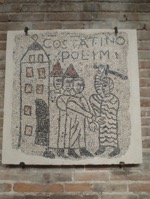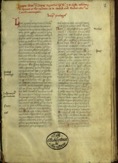
The Council of Ferrara-Florence (1438/39) is considered the last remarkable, though ultimately unsuccessful, attempt in the Middle Ages to restore church unity between the Latin West and the Greek East. Throughout history, certain events and their enduring consequences had nourished a growing scissure that ever deepened the alienation between the churches – just to mention a few of the most striking: the so-called Photian schism at the end of the 9th century, the mutual excommunications in 1054, the sack of Constantinople in 1204 followed by the Latin Empire of Constantinople until 1261, the Byzantine Emperor’s acceptance of an eventually short-lived church union on the Second Council of Lyons in 1274 (succeeded, though, by its refusal in 1282) etc. Following the history of reception of these events in the Middle Ages and beyond is like dealing with not only one, but several “points of no return”: While this might seem contradictory to itself, it nevertheless helps to understand (1) that dating the breakout of the schism depends on what kinds of sources we rely on, and (2) that, again throughout history, there have been many attempts and frequent parallel endeavours to heal this fracture between the churches.

One milestone of such an effort was the lifetime achievement of an anonymous Dominican from the year 1252, a learned theologian who dedicated himself to an in-depth study of the Greek language, theology, and church life. Based on this knowledge, he was capable and well-equipped to write a theological treatise “Against the Greeks” (Tractatus contra Graecos) in Constantinople, which eventually became a bestseller in controversial literature dealing with how to argue in Greek-Latin debates. Up to the 15th century, it greatly influenced theology and the Latin church and deeply affected how Latin authors perceived the Greek church. The anonymous Dominican was the first theologian who determined what later appeared on the agenda of the union councils in Lyon (1274) and Ferrara-Florence (1438/39): That a number of four issues of conflict – filioque, purgatory, azymes, and Roman primacy – had to be solved in order to proclaim the unity of the church, something which he didn’t see as lost, but as highly at risk. In a manner of fraternal correction, the Dominican author sought to convince the Greeks of their errors by quoting their own reliable sources, i.e. the Greek fathers and church councils, and by demonstrating that they all, in fact, supported the Latin positions. Additionally, he provided his (indented Latin) readers with a dossier of contemporary Greek writings in a Latin translation along with a commentary which was both meant to keep the readers informed about the situation on the spot and to support their argumentation in ongoing debates.

From today’s perspective, the actual value and impact of the Tractatus contra Graecos is impaired by the fact that today it is known only based on an early modern edition of 1616[1], which is deficient and at times almost incomprehensible. This is why an updated and reliable critical edition is a particularly urgent task: Based on 30 manuscripts that are known thus far and that are kept in libraries in Central and Southern or Southeast Europe, a critical edition will lead to a reconstruction of the text ranging from the time it was written in mid-13th-century Constantinople up to how it was used as a handout and source of information on the councils of the Late Middle Ages by leading Latin theologians. The surviving manuscripts give evidence that not only in the 15th century, but also already by the author himself, the treatise has been remodelled and shaped according to the needs of time and occasion. Both the critical edition of this Dominican key work and its history of reception contribute to a better understanding of the relationship between Rome and Byzantium in the Middle Ages and, thus, to a more detailed knowledge of the history of today’s Catholic and Orthodox churches.
—
Dr. Andrea Riedl
Senior research fellow at the Department of Theology/University of Vienna and currently visiting researcher at the Medieval Institute/University of Notre Dame.
[1] Ed. Petrus Stevartius Leodiensis (1549–1624), Tomus singularis insignium auctorum, tam graecorum, quam latinorum, Ingolstadt 1616, 487–574, and reprinted in Migne’s Patrologia graeca, PG 140, 487–574. This is the transcription of a manuscript of the Bavarian State Library in Munich, Clm 110 (fol. 1r-88).
